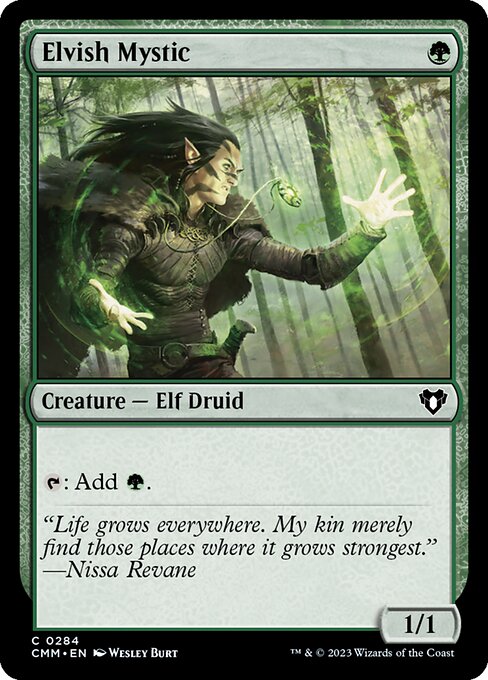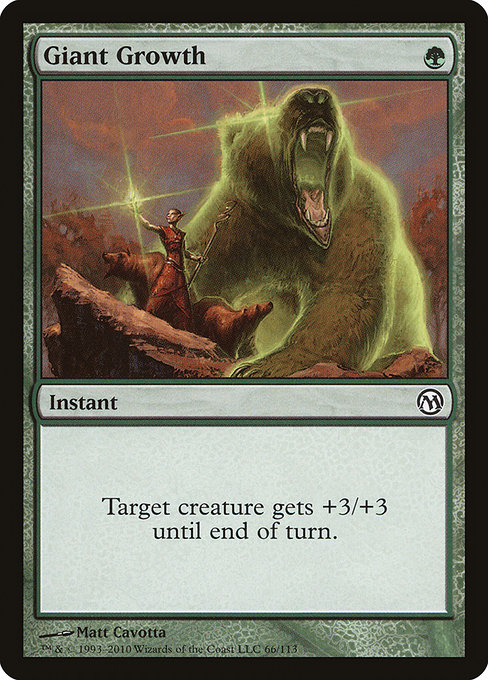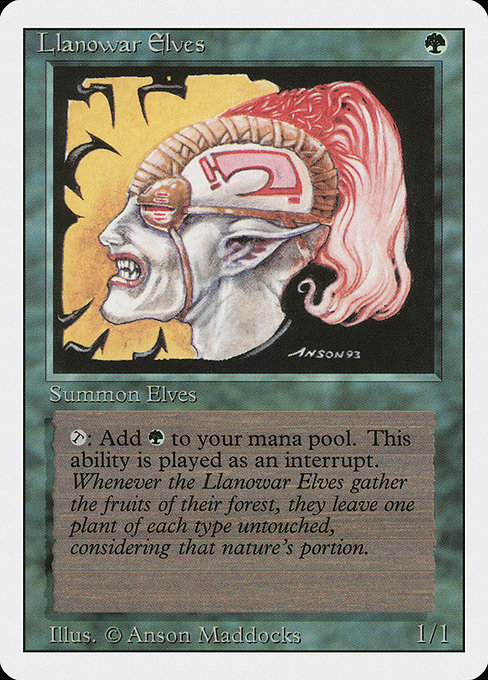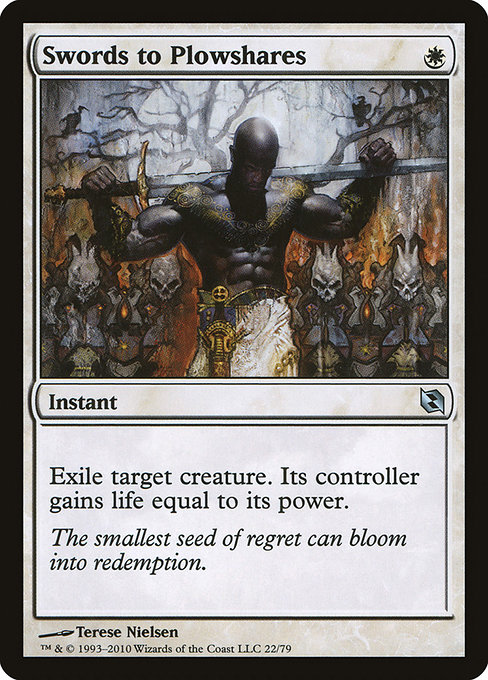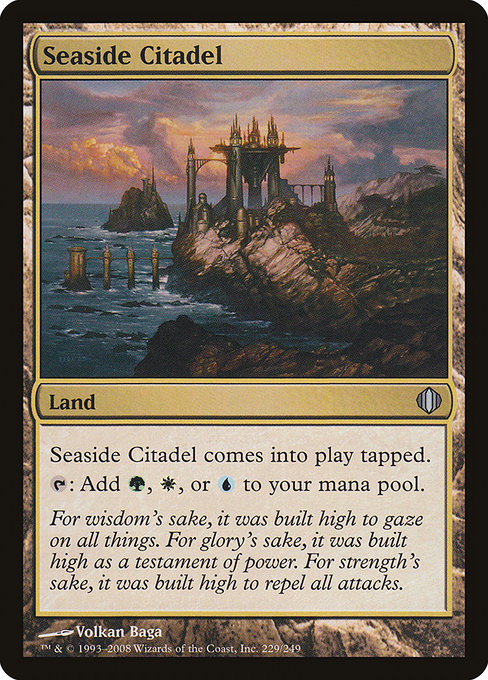
Seaside Citadel

Guide Sections
Strategy Guide
Last updated 2025-07-06Quick Summary
Seaside Citadel is a land card that enters the battlefield tapped. This means you cannot use its ability to produce mana during the turn it enters the battlefield. Its activated ability, represented by "{T}: Add {G}, {W}, or {U}", allows you to tap it (represented by "{T}") to add one mana of either green ({G}), white ({W}), or blue ({U}) to your mana pool. You choose which color of mana to add each time you activate the ability; you are not obligated to add the same color each time.
This multi-colored mana ability makes Seaside Citadel useful in decks that utilize those colors. It's particularly valuable in three-color decks featuring green, white, and blue, providing a consistent source of mana for those colors without requiring additional dedicated mana fixing like Prismatic Vista or Reflecting Pool. However, its tapped status on entry means it won't immediately contribute to your mana pool, which should be factored into your mana curve planning. For example, it won't help cast a turn-one one-mana spell.
The ability to choose which color of mana to add provides flexibility. This is important for adapting to the needs of your strategy at any given moment. If you need green mana to cast a creature, you can choose to produce {G}. If you need white mana for a removal spell, you can produce {W}, and so on. There are no restrictions on how often you can activate the ability; it can be used every turn as long as it remains untapped. Note that effects that prevent you from tapping lands, such as Winter Orb, will prevent you from using Seaside Citadel's ability. Similarly, effects that prevent you from adding mana from lands will also prevent its usage.
Seaside Citadel's strategic application hinges on its ability to produce three different colors of mana – white, blue, and green – albeit at the cost of entering the battlefield tapped. This makes it a powerful tool for three-color decks that need consistent mana fixing but may not have space for dedicated ramp spells like Rampant Growth or Cultivate. It shines in decks that can afford to wait a turn for the mana, or which are built around strategies that don't require explosive early-game plays.
The primary archetypes benefiting from Seaside Citadel are those running three-color combinations involving white, blue, and green. Examples could include strategies utilizing creatures with high mana costs, such as Colossal Dreadmaw or Hydroid Krasis, or those that rely on a synergistic mix of white's protection/board control, blue's counterspells/card draw, and green's ramp/creature synergies. Decks with a control focus, or those that prioritize value and late-game power, find Seaside Citadel particularly useful due to its long-term value outweighing the temporary mana delay. It functions as a reliable mana source, acting as a consistent land that supports a complex mana base without taking up valuable slots typically reserved for dual lands or fetch lands.
Roles Seaside Citadel effectively fills include:
- Mana Fixing: Its primary function is to smooth out the mana base for three-color decks, reducing the risk of color screw.
- Consistent Mana Production: While it enters tapped, its ability to produce {G}, {W}, or {U} provides long-term reliability.
- Budget-Friendly Mana Base: In comparison to rarer dual lands, Seaside Citadel offers a more accessible option for building diverse mana bases. It's a solid choice for players constructing competitive decks on a budget.
The tapped condition is important to consider. Decks that heavily rely on early-game aggression or fast combos are less likely to make use of Seaside Citadel due to the tempo loss.
Seaside Citadel's value lies in its ability to produce three different colors of mana – green, white, and blue – making it a versatile land for multi-colored decks. Its tapped condition on entry is a minor drawback, but this is easily offset by the color fixing it provides. Decks that want to utilize cards from multiple color identities will benefit most. Therefore, the key to successful deckbuilding with Seaside Citadel involves focusing on strategies that leverage this tri-color mana base.
One obvious synergy is with cards that benefit from having access to all three colors. For example, Lord Windgrace appreciates the mana fixing, allowing easier access to its powerful activated ability. Similarly, commanders like Ramos, Dragon Engine or Kalamax, the Stormsire thrive on having a consistent supply of colored mana. These commanders all want to play many expensive spells, and Seaside Citadel helps ensure the mana is available.
Another strategy is to build around cards with color-intensive activated or triggered abilities. Cards like Teferi, Time Raveler require both white and blue mana to effectively counter threats or manipulate the game's timeline. Similarly, Baneslayer Angel's white and its powerful effect works well when paired with a wider color base. Adding green allows for additional ramp strategies to facilitate playing these high-cost spells sooner.
Finally, consider decks that have a strong element of ramp. Cards like Rampant Growth, Cultivate, Kodama's Reach and other similar ramp cards, will help mitigate the "enters the battlefield tapped" drawback of Seaside Citadel, ensuring you have the mana available when it's needed to play the stronger, more expensive cards that your tri-color deck relies on.
Seaside Citadel's viability hinges heavily on its mana fixing capabilities within formats that appreciate tapped lands. Its ability to produce {G}, {W}, or {U} makes it a valuable inclusion in three-color decks utilizing those colors, particularly those that aren't overly reliant on explosive early game plays. The tapped status is a significant drawback, however, limiting its appeal in aggressive strategies.
In Standard, Seaside Citadel's usefulness is questionable. The fast-paced nature of the format often necessitates untapped lands for consistent turn-one plays. While three-color decks exist, many prioritize efficient mana bases with fetchlands like Flooded Strand and Windswept Heath to maximize consistency, rendering a tapped dual land less attractive. However, in slower, more controlling Standard metas, it might find a niche.
Historic presents a slightly more optimistic outlook. The format's slower pace and broader card pool allow for more leniency towards tapped lands, especially in decks that don't need to curve out aggressively. Seaside Citadel's ability to provide access to {G}, {W}, and {U} could be useful in a variety of strategies, perhaps even finding a home in some midrange builds. However, it will still face stiff competition from better mana fixing options.
Commander is where Seaside Citadel shows the most promise. The slower speed and higher mana curve of Commander are more forgiving of a tapped land. Its tri-color production makes it a viable option for many three-color Commander decks, particularly those not overly reliant on fast mana. In a format with a wider selection of ramp spells like Rampant Growth and Cultivate, the tapped nature is less of a penalty. Additionally, the sheer number of cards available allows for diverse strategies where a slightly slower early game isn't debilitating.
Seaside Citadel's flexibility shines in situations demanding diverse mana production. Imagine a mid-game scenario where you control a Luminous Geist and a Deeproot Elite. You need both white and green mana to activate their abilities effectively, but your other lands are solely Forests and Plains. Seaside Citadel, even entering tapped, provides the crucial missing color to power both creatures simultaneously, allowing for a strong swing turn.
Another impactful scenario arises in the late game when facing a control opponent. Assume your board is mostly developed but your hand contains a powerful but expensive spell, such as Finale of Devastation. This requires a significant mana investment across multiple colors (likely green and white, or potentially even blue depending on the targets). While the Citadel entering tapped delays its immediate impact, it adds critical colored mana for the subsequent turn, securing the necessary resource to cast your game-winning spell.
Finally, consider a situation where you are playing a three-color strategy involving white, blue, and green. Early game mana fixing can be tricky, and you might find yourself needing to stretch your resources. While you may not immediately want to use the tapped ability, the option to add any of those three colours from a single land makes this card valuable for smooth mana development early on, and avoids the need to play more basic lands and potentially lose out on development.
Seaside Citadel, a humble uncommon land from the Alara block, holds a quiet but significant place in Magic: The Gathering's history. Its simple yet effective ability to produce green, white, or blue mana upon tapping made it a staple in three-color decks utilizing those colors, especially in limited formats like drafts and sealed. While it never achieved the iconic status of dual lands like Underground Sea or Savannah, its consistent presence across various limited environments demonstrated its value. The mana fixing it provided was crucial, particularly in early turns where accessing specific colors was vital for casting key spells.
Its impact on constructed formats was more subdued. The requirement to enter the battlefield tapped significantly limited its appeal compared to untapped dual lands or even fetchlands like Flooded Strand. While useful in decks that could afford a slightly slower mana base, the tempo loss associated with the tapped condition often made it a less desirable choice in highly competitive constructed play. Despite this, its unassuming nature made it a reliable component of numerous casual and budget-oriented constructed decks, proving its versatility across the spectrum of Magic play.
Reprints of Seaside Citadel were infrequent, reflecting its unspectacular but dependable nature. It appeared in various supplementary sets and products intended for casual or limited play, solidifying its role as a workhorse in those environments. The absence of frequent reprints, however, further emphasizes its lack of a significant presence within the top tiers of competitive play. Its legacy is not one of groundbreaking innovation, but rather of consistent, reliable service as a vital mana-producing tool for numerous players across various formats and skill levels.
Seaside Citadel's flavor text is unfortunately absent, leaving its connection to the ala set's theme somewhat ambiguous. However, its name and ability strongly suggest a coastal location, perhaps a fortified city built near the ocean, controlling access to both land and sea. The art would ideally reflect this – a sprawling city with visible walls, perhaps overlooking a body of water, subtly hinting at the tri-colored mana production. The inclusion of white, blue, and green mana is evocative of a location where land-based, sea-based, and possibly nature-based forces intersect. This blends well with the general fantasy setting of most Magic sets, but without further context from the ala set's theme, it's difficult to pinpoint a specific connection beyond this broad interpretation. It functions similarly to other multicolor lands like Hallowed Ground, offering access to multiple colors but entering the battlefield tapped, reflecting the trade-off for its utility. The uncommon rarity is appropriate, considering its versatility compared to basic lands but comparatively limited power compared to more powerful mana-producing lands such as Command Tower. The untapped mana producing lands are more powerful, reflecting their higher rarity. The tapped nature of this land balances its multicolor ability.
The Seaside Citadel's uncommon rarity suggests it's not intended to be a budget powerhouse. While it provides access to three colors – green, white, and blue – its tapped entry significantly limits its early-game impact. This makes it less desirable than many other options for budget decks aiming for fast starts. Several cheaper lands offer comparable functionality, albeit with trade-offs.
For example, Terramorphic Expanse and Evolving Wilds can fetch basic lands, providing color fixing at the cost of needing a land in hand to do so. These fetchlands are often found at common rarity and are generally more budget-friendly. While they don't produce mana on the turn they enter the battlefield, they offer long-term value in providing the necessary colors later in the game. Basic lands themselves, of course, are the cheapest option, offering a predictable mana base at the cost of less flexibility. If needing to fix multiple colors, Reflecting Pool provides an alternative but at a significantly higher cost due to its rarity and the need for several other lands to function effectively. Ultimately, whether Seaside Citadel is "budget-friendly" depends heavily on the context of the specific deck being constructed, but considering the readily available and cheaper alternatives, it isn't the most economical choice.
Seaside Citadel's seemingly simple ability belies its strategic utility in advanced deckbuilding. While primarily a mana-fixing land, its tapped entrance condition and flexible color production offer subtle advantages in specific strategies.
One effective use lies in decks focusing on early interaction. The tapped entry is less impactful if your game plan hinges on deploying creatures or other threats later, allowing you to utilize the mana from Seaside Citadel to effectively disrupt your opponent's early game plays with cards like Counterspell or Path to Exile. This is particularly relevant in decks which can afford to wait a turn or two to deploy their key threats.
Another strategic application arises in decks aiming to ramp into powerful late-game spells. The dual colored mana provided can support the casting of expensive spells with multiple color requirements, particularly those involving green and white, or green and blue. Combined with ramp spells like Rampant Growth or Cultivate, Seaside Citadel can smoothly facilitate a consistent mana base for these high-cost cards. The tapped entry is less significant when the delayed mana production is offset by the power of your eventual game-ending play.
Furthermore, Seaside Citadel's tri-color potential, though unusual for a common land, becomes beneficial in specific three-color strategies. While it won't solely support a three-color deck, incorporating it alongside other lands offering the missing color, such as Flooded Strand, can provide additional mana fixing without sacrificing consistency. Its ability to add any one of three colors enables flexible mana production according to the needs of the turn.
A common mistake with Seaside Citadel is failing to account for its tapped condition upon entering the battlefield. Players sometimes overlook this and try to use it immediately for mana production, resulting in a missed opportunity during the turn it's played. This is particularly impactful in aggressive strategies where early mana is crucial. The delay can significantly hamper the development of a fast-paced game plan.
Another error stems from misjudging its utility relative to other lands in a deck. While Seaside Citadel offers access to three colors ({G}, {W}, and {U}), its tapped status means it might not be worth including if the deck isn't designed to deal with the delayed mana. Players might mistakenly include it in a deck lacking sufficient ramp or mana fixing, ultimately leading to mana screw or flood, especially when compared to untapped dual lands such as Hallowed Fountain or Windswept Heath. A careful consideration of the deck's mana curve and overall strategy is necessary before including this card. Simply having access to three colors isn't enough to justify its inclusion if the opportunity cost of a tapped land is too high.
Seaside Citadel is a useful land offering mana fixing in three colors: green, white, and blue. Its value lies in its ability to support strategies utilizing those colors, particularly those that don't rely on explosive early game plays due to it entering the battlefield tapped. It shines in decks that can afford to wait a turn for its mana, such as midrange or control strategies featuring cards like Arrester Geist (if white is a main color) or Coiling Oracle (if blue is a main color). While not as powerful as untapped dual lands, its flexibility makes it a solid inclusion in decks needing access to green, white, and blue mana, especially in formats where the mana base needs to be more budget-conscious.
